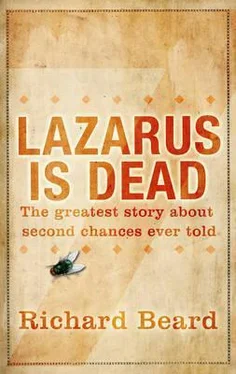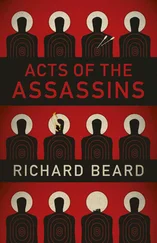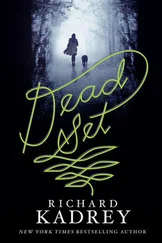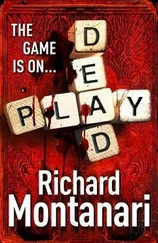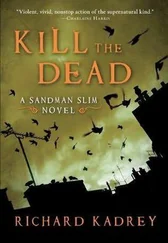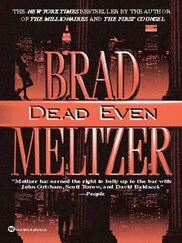According to Paul in one of his letters, the crucifixion of Jesus ‘ disarmed the rulers and authorities and made a public example of them, triumphing over them in it ’ (Colossians 2: 15).
There may be some truth in this.
Cassius, for example, regrets that crucifixion is considered any kind of solution. His own proposal of a client messiah would be more effective at keeping the peace. But the crucifixion, like the resurrection of Lazarus, is happening nevertheless, and the death of Jesus may have its uses. A messiah does not get executed like a common criminal, nailed into the nearest olive tree. Messiahs escape death, and they escape the Antonia Fortress. They are protected by god from the lethal Sicarii.
Crucifixion is ugly and deplorable, but in this instance the fault lies with the regional god. All religions should be true, so claiming to be the one true god is as aggressive a manoeuvre as a divinity can make. Look down now on Jesus. Look at the results. Divine arrogance will not be tolerated, not by other gods, not by the Roman empire.
*
It is midday. The sky darkens to the colour of bad meat, silver and purple.
Jesus is hoisted off the ground, and his arms sized against branches. This tree has been used before. One of his arms is angled backwards and lashed to a branch so that his shoulder has to twist, the other is crooked and slightly higher. Two other condemned men go on either side, one in front and the other about level.
The Romans have no interest in aesthetics, or symmetry, as long as the arms are above the head to maximise the pain. The feet, too, must be clear of the ground. Jesus will die with his blackened toes inches from the earth and salvation.
Only the heels are nailed. One four-and-a-half inch spike on either side. The scratch of splintered bone is audible above the heavy thud of the mallet. A woman shrieks, and can’t stop herself. She goes on and on.
Lazarus feels no particular compassion.
Death is a big episode, but it is not the end. It is, after all, only death, however spectacular. Death is not the climax it used to be, not for Lazarus.
The clouds close in — ‘When it was noon, darkness came over the whole land’ (Mark15: 33), and this is when Lazarus is certain. There is a god and he is watching, providing the ideal weather for two boys from Nazareth, clouds blocking the sun that otherwise would blind them to handholds as they climb.
Lazarus watches Jesus. He observes the strain on his body, toes flexing for solid ground, head dropped low on his chest.
Look at me. Look up and look at me. He wills Jesus to obey. Believe in me, and take strength from me.
Jesus looks up.
In the absence of compassion Lazarus is calm, confident about what he needs to do. He projects his thoughts through and beyond the eyes of Jesus, and there inside his friend’s skull he recognises his own death, a brain crying out for an instant and then another instant more of life.
I cannot die, Jesus thinks, with my thoughts and memories and feelings. I have seen things and done things that other people will never see and do.
So has everyone else, Lazarus reminds him. We all die.
Look at me. Lazarus is not giving up. Look, here I am, standing on the shore. I will not intervene, but everything will turn out fine. Every time Jesus raises his chin from his chest his eyes search out Lazarus.
You’re nearly there, Lazarus thinks. Come on, it’s easy.
Death is nothing and there is nothing to fear.
This is what Lazarus is for.
The hours that follow are described in the gospels. Jesus suffers. At some point a sponge soaked in sour wine is lifted to his lips on a stick. This is cruel or kind, designed to mock him or to give him strength: no one can remember.
Many in the crowd would have been hoping for better entertainment. ‘ Let the messiah, the king of Israel, come down from the cross now, so that we may see and believe ’ (Mark 15: 32). They note the sudden storm-clouds, the reputation of Jesus, and the presence of Lazarus. They assume there’s a good chance of seeing a spectacular reversal, and with luck even a miracle.
Jesus takes three hours to die, which for a crucifixion is neither mercifully short nor proof of abnormal endurance. It is an average, ordinary life expectancy when a body is mistreated in this way.
The influence of Lazarus is evident to the end and beyond. When Jesus stops breathing, the soldiers have orders to confirm his death. ‘ But when they came to Jesus and found that he was already dead, they did not break his legs. Instead, one of the soldiers pierced Jesus’s side with a spear, bringing a sudden flow of blood and water ’ (John 19: 33–34).
Jesus continues to improve on the death of Lazarus. Crucifixion, then the spear to make sure. No one will ever doubt that he died.
‘Jesus said, “It is finished.” With that, he bowed his head and gave up the spirit’ (John 19: 30).
It is finished. For Jesus it is finished, but not yet for Lazarus.
1
IN CHURCHES OBSERVING the Byzantine Rite, Lazarus Saturday is a leading religious festival. Bright colours are used for vestments and the Holy Table, and, uniquely in the Christian year, the standard order of service for a Sunday can be celebrated on a different day of the week.
For one Saturday every year, a week and a day before Easter, Lazarus is the equal of Jesus. In the Apolytikion for St Lazarus they sing We cry out to you, O Vanquisher of Death! On Lazarus Saturday the Russians bring out the caviar. The Greeks make a spiced bread called Lazarakia , shaping the dough into a man bound for burial.
Catholics and Protestants are less enthusiastic: perhaps they’re inhibited by the three out of four gospel writers who ignore Lazarus completely. In some ways they’d prefer him to disappear, but Lazarus keeps coming back. The memory of Lazarus is stubborn, and insists on his survival.
In Jerusalem on the Saturday after the execution of Jesus, one week after the resurrection of Lazarus, it is feasible that Lazarus Saturday will become the central day of a newly forged religion. Jesus will be secondary, because Lazarus has vanquished death. He is the survivor, and the only living pathway to god.
2
The evangelist Mark provides the fullest record of Holy Week. He reports on every day between Palm Sunday and Friday’s crucifixion, but he has nothing to relate about the Saturday. For Jesus, at that point, the story is finished. He said so himself.
From Friday afternoon at about three p.m., when Jesus dies, Lazarus becomes god’s representative on earth. Something extraordinary would need to happen to displace him.
Lazarus watches strangers haul his friend down from the olive tree. They fumble the body, a heavy object thumping hard to the ground. The corpse is gathered up again, gently, as if the dead care.
The crowd breaks up, falling away from Lazarus. He doesn’t notice them go, nor, at first, does he realise that someone has come to stand very close beside him.
‘You’re still alive,’ Cassius says. ‘You’re a very lucky man.’
Luck has nothing to do with it, because Lazarus could have foretold this moment, like a prophet. As a child he’d felt special, and without him Jesus was always likely to come to harm. He remembers the amphitheatre in Sephoris, when he’d saved Jesus from falling. He’d never understood how he’d managed to do that.
From inside the city comes the single note of a trumpet, announcing the start of the Sabbath. Stragglers turn away from the manhandling of the body of Jesus: there is a rush to bury him before the sun goes down.
‘You have the rest of your life in front of you,’ Cassius says. ‘The man who came back from the dead.’
Читать дальше
